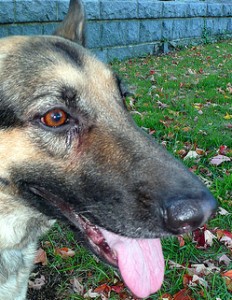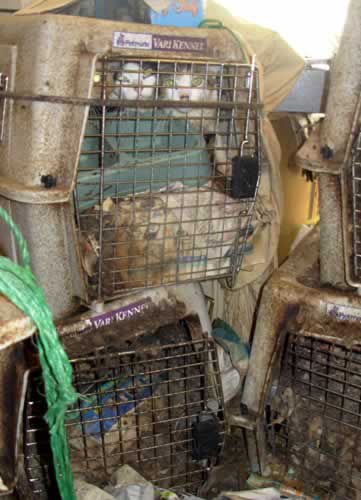
German Shepherd
I have an old friend who is beautiful, witty and fairly successful. She’s been married to her handsome husband for many years and, by all appearances, leads a happy life.
We used to be very close, sisters almost. I’d come stay with her and she’d come stay with me, and our husbands would tolerate the closeness because we were such good friends and loved each other a bunch.
That is until her dog bit my daughter in the face for no reason whatsoever.
To this day I get upset when I think of it.
But my upset is not with the dog. It’s with the owners of the dog. With my old friend and her husband.
I understand dogs. I often know what they’re thinking and have, on occasion, provided a voice for them when they had something important to say.
I even understand mean dogs. Mean dogs are usually predictable, they’re mean, and they stay locked up when strangers are around.
Dangerous dogs, on the other hand, I don’t understand. By dangerous I mean unpredictable. Nice most of the time until they turn and try and kill you or someone close to you.
I read about them all the time. The dog who has been a family pet suddenly turning and killing a child, its owner, another pet.

Dangerous German Shepherd
I’ve met only a couple of truly dangerous dogs, ever. Dogs that I was unable to reach, dogs that I could not train to respect me and not bite others. Dogs that would hit a point of ‘madness’ where their instinct to attack was so strong that nothing I did would reach through the frenzy.
It’s a frightening moment to realize that your voice is not reaching the dog.
Now this particular dog my old friend owns has a history. It wasn’t the first time he’d bitten someone while I was standing there. Earlier another friend had been attacked by him and bitten to the point of requiring stitches. After that attack (and the owners being deeply apologetic but really doing nothing effective to handle their dog), I discovered that the dog had bitten before and the county had taken the dog away twice for bites and each time the family paid over $500 to get him back. The county told them the next time he bit, he’d be put down.
A few months after that incident I came to town for a visit and stayed with my old friend, her husband and the dog. Daily I’d work with the dog, a big German Shepard, exercising him, handling his aggressive outbursts, keeping him calm, attentive and friendly.
But there were these moments, these episodes, where he’d just be by himself and he’d start growling and looking strange, eyes defocused. I’d sharply command his attention at these times and he’d stop, look at me, wag his tail and bring a ball over to play. I was pleased to see the improvements in him and felt he was responding nicely to the work I was doing.
Until he bit my daughter’s face.
Unprovoked he rushed, leaps up and snaps at her face tearing her cheek open.
As I sat in the emergency room watching my distraught daughter getting 80 stitches put into her once perfect cheek, my friend was pleading with us not to report the incident to the authorities. She promised she’d take the correct action to handle her dog once and for all.
And so I made up a story so the dog would not be taken away from my best friend.
Looking at it now, I realize that the relationship my friend and this dog have is similar to battered spouse syndrome. Everyone can see the insanity that exists except the battered spouse, who makes excuses and hides the bruises and the bad news from others.
And my friend? Right after the attack on our daughter, we stopped talking because, despite this newest incident and all my conversations with her, my research on what to do to handle aggression in dogs, it all fell on deaf ears, they did nothing. To them it was ‘he’s eating the wrong food’, ‘my husband is not exercising him enough’ ‘his thyroid is acting up’, excuse, excuse, etc.
It wasn’t until later I learned he had bitten several other people I knew, some badly, but no one was talking about it. The county incidents were reports from strangers. I’m sure there are several other incidents that I don’t know about and probably never will.
Eventually my old friend and I mended our relationship to the point where we talk now, but we never mention the dog and I’ve not been back to their house since the incident 3 years ago.
And it’s been 18 months since we’ve seen each other because we live in different states now.

German Shepherd (not the dog in the story)
Recently I heard that her husband was coming for a visit to our city, his flight was booked and his arrival date a few days away.
Abruptly, he canceled his trip.
Then I discovered why.
The reason he could not make the trip was their dog had just bitten the wife’s new best friend horribly and the girl required medical treatment.
I don’t know what has happened to the dog………my friend has stopped taking my calls for now.
I wonder why?
Here is one solution for dangerous dogs and owners who can’t bear to give them up.
It’s called Canine Disarming and, similar to disarming a gunman, these dangerous biting dogs are disarmed of the weapon they are packing, namely their sharp, pointed teeth.
Here is a recent article from the LA Times on the topic, and it deals with Cotton, a dog who, despite the owner doing everything she could think of to cure him of biting, was unsuccessful in her attempts so she was willing to try this new technique.
Weigh in on what you feel about this as a solution for dangerous dogs. Do you have a different solution? If so, let us know by commenting at the bottom of this article.
Is Canine Disarming the Solution for Aggressive Dogs?
An aggressive six-year-old American Eskimo dog named Cotton recently underwent a highly controversial dental treatment known as canine disarming to trim and smooth his teeth.
Cotton’s owner Diane Krieger had tried just about everything — puppy training classes, self-help books, and even assistance from “Dog Whisperer” Cesar Millan — to tame her pup’s dangerous bad habit, but the biting persisted. She even looked into dog rescue groups, but most refused to take pets with a history of biting.
Last month, as an alternative to euthanization, Krieger resorted to the $1,600 treatment. Veterinary dentist Dr. David Nielsen performed the canine disarming procedure in hopes of making Cotton more obedient — or at least, less harmful.According to the LA Times, Nielsen used a laser to shave 4 millimeters off Cotton’s sharp teeth. He then gave the trimmed teeth a soft finish with a human-grade composite. Think of it as doggy caps.
While Krieger felt she had no other option for her fierce 35-pound dog, the American Veterinary Medical Association feels otherwise. The organization is against canine disarming, saying it doesn’t address the behavioral problems that leads to biting. Yet, the American Veterinary Dental College accepts the use of the procedure in “selected cases,” the LA Times reported.
According to Dr. Nielsen, following the disarming procedure and recovery, “most dogs are intelligent enough to understand they are no longer knife-damaging biters, but more like pinchers at best.”
Since undergoing the procedure, Cotton’s bite has weakened, but he still pounces at strangers in the Kreiger’s home. Only time will tell if Cotton will learn that his ferocious fangs have turned into dull dentures.
Source LA Times
Pictoral on the procedure
http://www.latimes.com/features/home/la-hm-0725-cotton-pictures,0,2409055.photogallery






